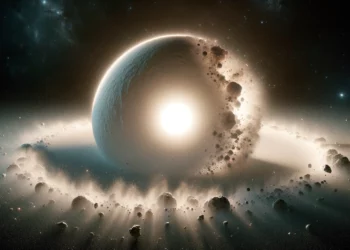Radio pulsars—rapidly spinning neutron stars—are well-studied objects. They typically spin many times a second to a few times per minute, each spin beaming a “pulse” of radio waves. We’re used to most pulsars having rotation periods of mere seconds.
However, in 2022, astronomers detected periodic radio pulsations that repeated much more leisurely: every 18 minutes. The pulses also outshone everything nearby, flashed intensely for three months, then just disappeared. The source was dubbed GLEAM-X J162759.5-523504 after the surface it was found in.
Since the initial discovery, nine more of these “long-period radio transients” have been found. Now, astronomers might know the reason for their slow pulses. They just had to check out a less-populated region of the Solar System.
“The long-period transients are very exciting, and for astronomers to understand what they are, we need an optical image,” said Curtin University associate professor Natasha Hurley-Walker, first author of new research published in The Astrophysical Journal Letters said in a press release. “However, when you look toward them, there are so many stars lying in the way that it’s like 2001: A Space Odyssey. ‘My god, it’s full of stars!’.”
This prompted the astronomers to look instead to quieter regions of the galaxy in the Puppis constellation, around 5,000 light-years away, using the Murchison Widefield Array in Western Australia, which can observe 1,000 square degrees of the sky every minute.
This yielded significant results. A new source, GLEAM-X J0704–37, caught the researchers’ attention because it displayed minute-long pulses of radio emission that recurred every 2.9 hours. This is much slower than previously discovered sources. Until now, the oddities had periods on the order of minutes or a fraction of an hour. Finding one that blinked only once every three hours set a new record.
But how can something spin that slowly and still produce intense radio pulses?
Pinpointing the Source
The team was able to pinpoint the location of the radio waves to one specific star using another SKA precursor, the MeerKAT telescope in South Africa. Following up with the SOAR observatory in Chile, they determined the star’s spectrum, finding it was a red dwarf, more specifically, a low-mass star known as an ‘M dwarf’.
But there had to be more to it than that.
“An M dwarf alone couldn’t generate the amount of energy we’re seeing,” Hurley-Walker said.
Red dwarfs are small, cool stars, making up about 70% of the galaxy’s star population. They are dim and long-lived, often showing modest flares, but they aren’t known for producing sustained, clocklike radio pulses.
Moreover, the timing of the pulses displayed a tiny pattern: the pulses didn’t arrive like perfect clockwork. Instead, their arrival times shifted back and forth slightly in a regular pattern. Such a shift strongly hinted that the radio-emitting object is in orbit around something else.
“Our data suggests that it is in a binary with another object, which is likely to be a white dwarf, the stellar core of a dying star,” Hurley-Walker said. “Together, they power radio emission.”
A white dwarf is the hot, dense core left behind when stars exhaust their fuel and shed their outer layers. White dwarfs have strong gravity and can have large magnetic fields, though typically not as strong as neutron stars.
So how do a red dwarf and a white dwarf generate a radio signal?
“The red dwarf probably produces a stellar wind of charged particles, just like our Sun does,” Hurley-Walker wrote in The Conversation. “When the wind hits the white dwarf’s magnetic field, it would be accelerated, producing radio waves. This could be similar to how the Sun’s stellar wind interacts with Earth’s magnetic field to produce beautiful aurora, and also low-frequency radio waves.”
According to the study, if the white dwarf spins very slowly—hours instead of seconds—then we see correspondingly slow flashes. This scenario offers a natural explanation for a slow, steady pulsation rate from a star that astronomers wouldn’t have pegged as a radio beacon.
“We already know of a few systems like this, such as AR Scorpii, where variations in the brightness of the red dwarf imply that the companion white dwarf is hitting it with a powerful beam of radio waves every two minutes,” Hurley-Walker wrote. “None of these systems are as bright or as slow as the long-period radio transients, but maybe as we find more examples, we will work out a unifying physical model that explains all of them.”
The discovery that a red dwarf and a white dwarf can mimic the periodic radio emission astronomers usually associate with neutron stars upends previous assumptions. Hurley-Walker said astronomers must now broaden their models of how and where coherent radio emission can arise. This could impact the understanding of stellar magnetism, mass transfer in binaries, and the end-of-life stages of stars.
“We’ve learned the power of expecting the unexpected,” Hurley-Walker wrote. “(A)nd we’ll keep scanning the skies to solve this cosmic mystery.”







